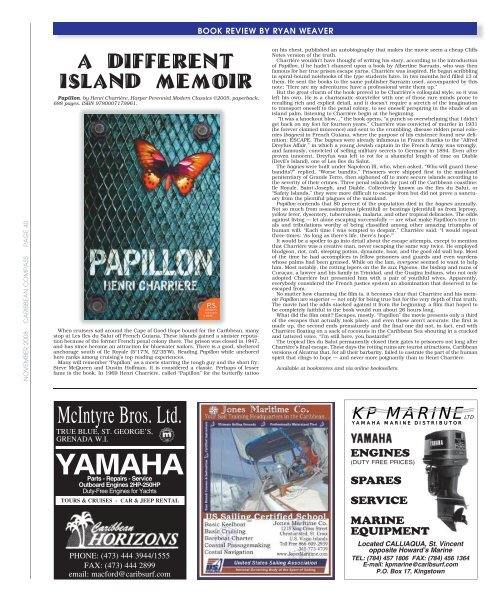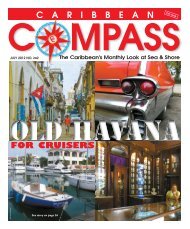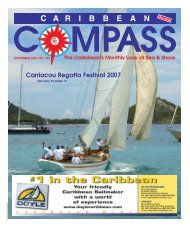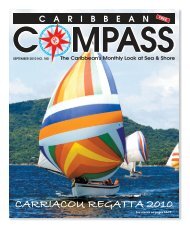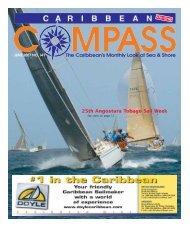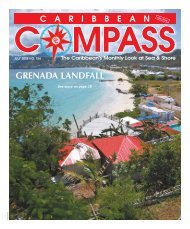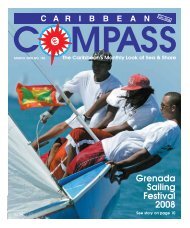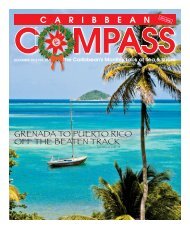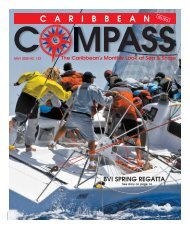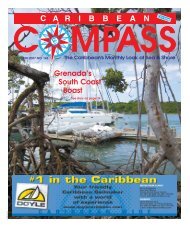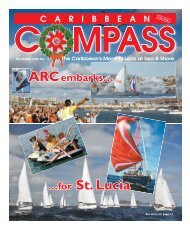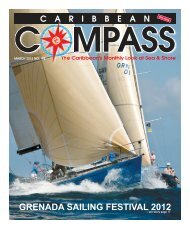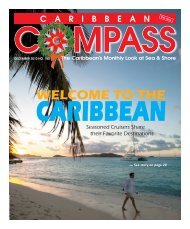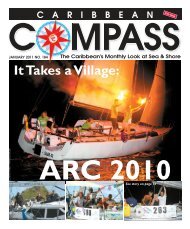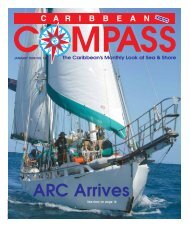A CRUISER'S VIEW OF BEQUIA - Caribbean Compass
A CRUISER'S VIEW OF BEQUIA - Caribbean Compass
A CRUISER'S VIEW OF BEQUIA - Caribbean Compass
You also want an ePaper? Increase the reach of your titles
YUMPU automatically turns print PDFs into web optimized ePapers that Google loves.
NOVEMBER 2008 CARIBBEAN COMPASS PAGE 40<br />
A Different<br />
Island Memoir<br />
Papillon, by Henri Charrière. Harper Perennial Modern Classics ©2005, paperback,<br />
688 pages, ISBN 9780007179961.<br />
When cruisers sail around the Cape of Good Hope bound for the <strong>Caribbean</strong>, many<br />
stop at Les Iles du Salut off French Guiana. These islands gained a sinister reputation<br />
because of the former French penal colony there. The prison was closed in 1947,<br />
and has since become an attraction for bluewater sailors. There is a good, sheltered<br />
anchorage south of Ile Royale (5°17’N, 52°35’W). Reading Papillon while anchored<br />
here ranks among cruising’s top reading experiences.<br />
Many will remember “Papillon” as a movie starring the tough guy and the short fry:<br />
Steve McQueen and Dustin Hoffman. It is considered a classic. Perhaps of lesser<br />
fame is the book. In 1969 Henri Charrière, called “Papillon” for the butterfly tattoo<br />
McIntyre Bros. Ltd.<br />
TRUE BLUE, ST. GEORGE’S,<br />
GRENADA W.I.<br />
YAMAHA<br />
Parts - Repairs - Service<br />
Outboard Engines 2HP-250HP<br />
Duty-Free Engines for Yachts<br />
TOURS & CRUISES - CAR & JEEP RENTAL<br />
PHONE: (473) 444 3944/1555<br />
FAX: (473) 444 2899<br />
email: macford@caribsurf.com<br />
BOOK RE<strong>VIEW</strong> BY RYAN WEAVER<br />
on his chest, published an autobiography that makes the movie seem a cheap Cliffs<br />
Notes version of the truth.<br />
Charrière wouldn’t have thought of writing his story, according to the introduction<br />
of Papillon, if he hadn’t chanced upon a book by Albertine Sarrazin, who was then<br />
famous for her true prison escape yarns. Charrière was inspired. He began scribbling<br />
in spiral-bound notebooks of the type students have. In two months he’d filled 13 of<br />
them. He sent the books to the same publisher Sarrazin used, accompanied by this<br />
note: “Here are my adventures: have a professional write them up.”<br />
But the great charm of the book proved to be Charrière’s colloquial style, so it was<br />
left his own. He is a charismatic storyteller with one of those rare minds prone to<br />
recalling rich and explicit detail, and it doesn’t require a stretch of the imagination<br />
to transport oneself to the penal colony, to see oneself perspiring in the shade of an<br />
island palm, listening to Charrière begin at the beginning.<br />
“It was a knockout blow…” the book opens, “a punch so overwhelming that I didn’t<br />
get back on my feet for fourteen years.” Charrière was convicted of murder in 1931<br />
(he forever claimed innocence) and sent to the crumbling, disease ridden penal colonies<br />
(bagnes) in French Guiana, where the purpose of his existence found new definition:<br />
ESCAPE. The bagnes were already infamous in France thanks to the “Alfred<br />
Dreyfus Affair,” in which a young Jewish captain in the French Army was wrongly,<br />
and famously, convicted of selling military secrets to Germany in 1894. Even after<br />
proven innocent, Dreyfus was left to rot for a shameful length of time on Diable<br />
(Devil’s Island), one of Les Iles du Salut.<br />
The bagnes were built under Napoleon III, who, when asked, “Who will guard these<br />
bandits?” replied, “Worse bandits.” Prisoners were shipped first to the mainland<br />
penitentiary of Grande Terre, then siphoned off to more secure islands according to<br />
the severity of their crimes. Three penal islands lay just off the <strong>Caribbean</strong> coastline:<br />
Ile Royale, Saint-Joseph, and Diable. Collectively known as the Iles du Salut, or<br />
“Safety Islands,” they were more difficult to escape from but did not prove a sanctuary<br />
from the plentiful plagues of the mainland.<br />
Papillon contends that 80 percent of the population died in the bagnes annually.<br />
Not so much from assassinations (plentiful) or beatings (plentiful) as from leprosy,<br />
yellow fever, dysentery, tuberculosis, malaria, and other tropical delicacies. The odds<br />
against living — let alone escaping successfully — are what make Papillon’s true trials<br />
and tribulations worthy of being classified among other amazing triumphs of<br />
human will. “Each time I was tempted to despair,” Charrière said, “I would repeat<br />
three times: ‘As long as there’s life, there’s hope.’”<br />
It would be a spoiler to go into detail about the escape attempts, except to mention<br />
that Charrière was a creative man, never escaping the same way twice. He employed<br />
bludgeon, riot, raft, sleeping potion, dynamite, boat, and the good old wall hop. Most<br />
of the time he had accomplices in fellow prisoners and guards and even wardens<br />
whose palms had been greased. While on the lam, everyone seemed to want to help<br />
him. Most notably, the rotting lepers on the Ile aux Pigeons, the bishop and nuns of<br />
Curaçao, a lawyer and his family in Trinidad, and the Guajira Indians, who not only<br />
adopted Charrière but presented him with a pair of youthful wives. Apparently,<br />
everybody considered the French justice system an abomination that deserved to be<br />
escaped from.<br />
No matter how charming the film is, it becomes clear that Charrière and his memoir<br />
Papillon are superior — not only for being true but for the very depth of that truth.<br />
The movie had the odds stacked against it from the beginning: a film that hoped to<br />
be completely faithful to the book would run about 26 hours long.<br />
What did the film omit? Escapes, mostly. “Papillon” the movie presents only a third<br />
of the escapes that actually took place, and even those aren’t accurate: the first is<br />
made up, the second ends prematurely and the final one did not, in fact, end with<br />
Charrière floating on a sack of coconuts in the <strong>Caribbean</strong> Sea shouting in a cracked<br />
and tattered voice, “I’m still here, you bastards!”<br />
The tropical Iles du Salut permanently closed their gates to prisoners not long after<br />
Charrière’s final escape. These days the rotting ruins are tourist attractions, <strong>Caribbean</strong><br />
versions of Alcatraz that, for all their barbarity, failed to castrate the part of the human<br />
spirit that clings to hope — and never more poignantly than in Henri Charrière.<br />
Available at bookstores and via online booksellers.<br />
KP MARINELTD Y AMAHA MAR INE DISTRIBUTOR<br />
ENGINES<br />
(DUTY FREE PRICES)<br />
SPARES<br />
SERVICE<br />
MARINE<br />
EQUIPMENT<br />
Located CALLIAQUA, St. Vincent<br />
opposite Howard’s Marine<br />
TEL: (784) 457 1806 FAX: (784) 456 1364<br />
E-mail: kpmarine@caribsurf.com<br />
P.O. Box 17, Kingstown


